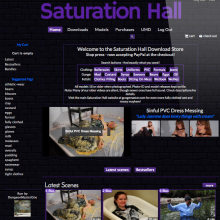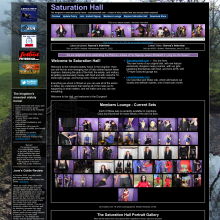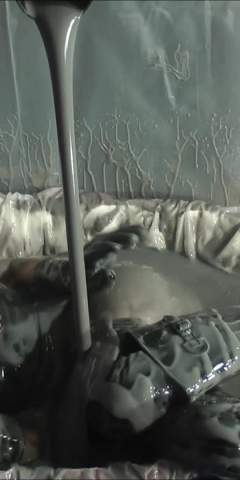|
|
|||
| forums: groups: | |||
|
"ms gunge--bad mixer or bad luck?"
Was feeling the need for some solo fun today and tried to mix up a bucket of MS gunge.
Tried the method of powder first followed by Luke warm water and mixing by hand straight away. Bucket was FULL of unmixed bits, complete waste. I didn't use the whole bag so tried a few different ways in a jug.
Powder in with hot water (use whisk)- bits
Luke warm water with powder sprinkled on top (whisk)- bits
It was almost foamy, not really gunge-like. Have I just got a bad batch? Or is this what to expect from the cheaper MS gunge? Think I'll be sticking to the proper stuff from now on. Just gutted as I'm sure I got some 'easy mix' stuff from them or maybe somewhere else in the past that worked absolutely great - much better than Nat, but this stuff wasn't good at all . Thankfully only bought two packets of it so not a huge waste, but still frustrating!
. Thankfully only bought two packets of it so not a huge waste, but still frustrating!
Tried the method of powder first followed by Luke warm water and mixing by hand straight away. Bucket was FULL of unmixed bits, complete waste. I didn't use the whole bag so tried a few different ways in a jug.
Powder in with hot water (use whisk)- bits
Luke warm water with powder sprinkled on top (whisk)- bits
It was almost foamy, not really gunge-like. Have I just got a bad batch? Or is this what to expect from the cheaper MS gunge? Think I'll be sticking to the proper stuff from now on. Just gutted as I'm sure I got some 'easy mix' stuff from them or maybe somewhere else in the past that worked absolutely great - much better than Nat, but this stuff wasn't good at all
 . Thankfully only bought two packets of it so not a huge waste, but still frustrating!
. Thankfully only bought two packets of it so not a huge waste, but still frustrating!Gungeguynorth!
I had exactly the same problem with a recent batch I bought for a shoot. I've dropped them a DM on twitter and they're looking into it, I'd suggest you do the same if you've had issues too!
I would recommend seeking the advice of Messyhot for this. Clixxx uses their slime in his shoots, he gets a particular sized bag that has the color mixed in it. But when Wamfan and I ordered from it, Wamfan used a paint mixer on low speed to mix it and it worked really well.
I had this problem the first couple of times I mixed gunge. I found that if you use a small hole strainer and slowly sift it while you mix helps prevents clumping a lot. I also use a paint mixer that attaches to a cordless drill. It makes everything so much easier. Hope this helps 

Personally used the extra thick ms gunge and mixed it with luke warm water by hand and it was completely smooth so must have been a bad batch
Wanting to be stuck in the middle of a mud pit
gungeguynorth said: Have I just got a bad batch? Or is this what to expect from the cheaper MS gunge? Think I'll be sticking to the proper stuff from now on.
So I'm going to try answer this for you in as simplified way as possible.
First thing to understand is that both MS Gunge and Natrasol are both Hydroxyethyl Cellulose. Cellulose is a repeating chain of molecules. The length of these chains can vary but chemical companies sort of separate them into chains of similar lengths and sell them as particular grades.
(A similar thing happens with crude oil being separated into hydrocarbons of various lengths to produce Bitumen, Diesel, Kerosene and Petrol they're all chains of hydrocarbons but vary in chain length).
The various grades of cellulose will produce a differing viscosities (thicker or thinner gunge) if you add the same quantity of that cellulose to the same quantity of water with grades with longer chains creating the thicker solution. HOWEVER this is just the case when you add the same fixed amount of cellulose to the same fixed amount of water. You can vary the thickness by changing the concentration so you can just add more of a grade with shorter chains of molecules to make a gunge of equal thickness to the one made with the grade with longer chains of cellulose.
(And to quickly answer whether using more of a lower grade to get the same thickness will be more expensive then it isn't that simple grades with larger chains tend to be more expensive for instance in the DIY section of MessyWorld website the larger chain HHR grade is more expensive than the typical HR grade however you have to offset this with shipping, shipping a kilogram will be the same for either grade but you could make slightly more with the higher grade, honestly I don't think the differences are worth quibbling over).
But anyway if you know what you are doing and vary the concentration to account for whatever grade you are using and the temperature of the gunge then you can make buckets of equal viscosity or thickness of MS Gunge, Natrasol or Methylcellulose. The first two being the same chemical and the later being so close to not make a difference in terms of the physical properties wammers seek in a gunge.
However as we know people make a big fuss over the difference of Natrasol vs Methylcellulose often because one was more prevalently used on one side of the Atlantic or the other and so is probably a combination of jingoism-influenced placebo effect and that most people rarely work out what concentrations to use to get equal thicknesses with the same colouring methods. But I could run a blind test on 100 sploshers with 10 buckets of Natrasol and Methylcellulose made to the same thickness and coloured the same way and expect none to guess them all 10 out of 10.
Anyway I've digressed.
So what is the difference between MS Gunge and Natrasol then if they are the same compound. Well there are other grades of Natrasol that are available that vary in other ways not just in the length of the chain of molecules. One such difference is in any grade of Natrasol that has an R in the grade name.
The R in the grade name such as HR250 is used to denote that Natrasol has been made/treated in a specific way to resist and slow down the process of a Natrasol solution hydrolysing or turning into gunge.
Why slow down the process? Well many hydrocolloids such as celluloses and polysaccharides can react so fast that they form clumps the worst for this in my experience is Xanthum Gum which can almost instantaneously produce lots of what are informally known as "fish eyes" as like a layer of slime sort of forms around small balls of unreacted powder such that the slimy ball with a powder centre seems almost eye like, if not finely scattered. Trying to break up these clumps if formed can then result in lots of air bubbles getting into the mix. Now I personally don't use Xanthum to make ordinary gunge, actually I have my own special prep method to specifically make a lumpy globular gunge that I've long given the nickname of "Kong Snot" but the general point I'm getting to is that R grades of Natrasol have been specifically made or treated to make the process of turning into gunge longer to make it easier to consistently mix smooth batches of Natrasol. Yes it takes a little longer- but that is the point, the faster it happens the less margin for error you have making it, if you screw up during the mixing window you can't really do much about it.
Now MessySupplies does not state what the grade of hydroxyethylcellulose they use for their MS Gunge but based off of the mixing instructions I suspect it is not an R-grade of hydroxyethylcellulose whereas the Natrasol they sell by default is the same HR250 grade the Basic Chemical Company used to sell to the BBC for Noels House Party (for BBC switched to shoving Xanthum Gum through a blender to make GYOB size tanks of gunge).
So in reality the only difference between MS Gunge and Natrasol on the MessySupplies website is that MS Gunge is not treated to slow down mixing so it will mix quicker but you have less margin for error not to screw it up whilst the Natrasol is slower to mix for more consistent results.
Personally I've always used the HR250 grade of Natrasol as it is what I always used to pick up from Basic Chemical Company whenever I passed High Wycombe (the saving on postage usually meant I could get an extra kilo instead) and honestly with warm water it only takes 5 minutes to mix (10 minutes if using cold water) and the larger margin for error mixing it does mean if working with someone else on a scene that has never made gunge before that it is easier to keep an eye/supervise them learning to make gunge than ensure they don't screw up a short window like mixing Xanthum. I also have a couple of special gunge recipes that mixes Natrasol with other substances to produce very different special effects and it requires the longer mixing time to be able to mix in the other ingredients/substances but that is stuff that won't be an issue for most other people. Others I'm sure will prefer the faster mixing times of the non-R treated stuff.
Oh and finally just for completeness regarding Natrasol grades grades with B in it are made to be more resistant to biological or chemical breakdown when mixed with other substances in industrial applications. Not entirely sure why MessySupplies sells H4BR250 grade Natrasol in their DIY section as I don't see how those properties benefit wammers unless it makes pre-made gunge more long life (which I can't be certain it does) if it does though they should probably be advertising that fact on the product page for that grade especially if it allows them to keep pools of gunge sitting around for more than the usual 7-10 days it takes for such gunges to breakdown.
I do warm water first to about 3cm deep in the bucket, then add the powder slowly and whisk til its all in, water still running. Then I switch to a large spoon and stir to knock out the air from the whisk - never had a problem with ms gunge
are you sure it was ms gunge and not methylcelluose or one of the other types? particularly the one that is just methylcellulose has always been awful to try and mix no matter which way I try it
are you sure it was ms gunge and not methylcelluose or one of the other types? particularly the one that is just methylcellulose has always been awful to try and mix no matter which way I try it
See my sites for tons of other content & coupons
I've had a few batches with some lumps- but nothing too bad on that front.
The true 'bad batches' on my end have been my own fault; mixing it too thick so it set into play-doh or using water thats too cold causing the powder to settle out before it could thicken- producing a solid jelly in the bottom of the bucket.
The lumpiest batches I've had seem to correlate with the times the bag has gotten damp before use (leaving unused bag in the bathroom between sessions)
Quite often I've used a shower head to fill the bucket (powder in first)- the turbulence from the shower seems to help mixing, but will make a bubbly layer on top.
Warmer water will make the gunge thicken faster- giving you less time to mix it, cold gunge can be easier but you'll be waiting for it to fully thicken and hopefully the heating works well.
Even with warm water, you might need half-hour or so for it to reach its full thickness.
Gently sifting the power into water as you mix takes a bit longer to make, but will eliminate 99% of lumps as this is often the technique recommended for mixing other gunges more prone to clumping.
This will naturally release more dry powder into the air- coating everything in a layer of gunge/powder. You may want to use a dust mask if you don't like the technicolour bogies when you sneeze.
The true 'bad batches' on my end have been my own fault; mixing it too thick so it set into play-doh or using water thats too cold causing the powder to settle out before it could thicken- producing a solid jelly in the bottom of the bucket.
The lumpiest batches I've had seem to correlate with the times the bag has gotten damp before use (leaving unused bag in the bathroom between sessions)
Quite often I've used a shower head to fill the bucket (powder in first)- the turbulence from the shower seems to help mixing, but will make a bubbly layer on top.
Warmer water will make the gunge thicken faster- giving you less time to mix it, cold gunge can be easier but you'll be waiting for it to fully thicken and hopefully the heating works well.
Even with warm water, you might need half-hour or so for it to reach its full thickness.
Gently sifting the power into water as you mix takes a bit longer to make, but will eliminate 99% of lumps as this is often the technique recommended for mixing other gunges more prone to clumping.
This will naturally release more dry powder into the air- coating everything in a layer of gunge/powder. You may want to use a dust mask if you don't like the technicolour bogies when you sneeze.
I've had mixed times, sometimes they have tons of lumps other times not so much, i think keeping the powder flat on the bottom is probably key and measuring too.
I've never had issues with MS Gunge, I generally buy the thick consistency and mix it by hand in warm to hot water. Powder in rhe bucket first, agitate to make sure that is no clumping, then water right in from the bathtub faucet. Maybe the forced of the faucet helps keep it from clumping? I have had some foam form on top, but that's just air from mixing. I let it settle for 10-15 minutes and cool slightly and these mostly go away. I've seen lots of people have the problem you describe and I've never been able to figure out what I specifically do differently. Maybe mineral content in water has something to do with it.
Saturation Hall, Langstonedale
Lord of the Pies
Powder first? Never done it that way. We fill a bucket with hot water, put the paint mixer in and start it spinning with the mixer at the top of the bucket, pour the bag of powder into the centre of the vortex, and mix. Never had a problem with it.
Saturation Hall - Forth! The Gungemaidens!
The main problem I find with the MS gunge is foam, it seems to hold on to a lot of air when whisked whereas the likes of natrasol don't seem to as much. 

Behind the Net Curtains of Suburbia
Same issue here recently. Definitely different to what I've had before. Consistency was more like Xanthan gum when mixing. Not convinced it was as labelled. Might also contact now I've seen this post.
gungeguynorth said: Was feeling the need for some solo fun today and tried to mix up a bucket of MS gunge.
Tried the method of powder first followed by Luke warm water and mixing by hand straight away. Bucket was FULL of unmixed bits, complete waste. I didn't use the whole bag so tried a few different ways in a jug.
Powder in with hot water (use whisk)- bits
Luke warm water with powder sprinkled on top (whisk)- bits
It was almost foamy, not really gunge-like. Have I just got a bad batch? Or is this what to expect from the cheaper MS gunge? Think I'll be sticking to the proper stuff from now on. Just gutted as I'm sure I got some 'easy mix' stuff from them or maybe somewhere else in the past that worked absolutely great - much better than Nat, but this stuff wasn't good at all . Thankfully only bought two packets of it so not a huge waste, but still frustrating!
. Thankfully only bought two packets of it so not a huge waste, but still frustrating!
Tried the method of powder first followed by Luke warm water and mixing by hand straight away. Bucket was FULL of unmixed bits, complete waste. I didn't use the whole bag so tried a few different ways in a jug.
Powder in with hot water (use whisk)- bits
Luke warm water with powder sprinkled on top (whisk)- bits
It was almost foamy, not really gunge-like. Have I just got a bad batch? Or is this what to expect from the cheaper MS gunge? Think I'll be sticking to the proper stuff from now on. Just gutted as I'm sure I got some 'easy mix' stuff from them or maybe somewhere else in the past that worked absolutely great - much better than Nat, but this stuff wasn't good at all
 . Thankfully only bought two packets of it so not a huge waste, but still frustrating!
. Thankfully only bought two packets of it so not a huge waste, but still frustrating! I've used powered from a bag once and didn't mix it right and made lumps around the area. But I learned I may still have the bag
Paint with play and surrender
I got a reply from Messysupplies who confirmed it was a bad batch and refunded me 

Just a general point about mixing methylcellulose. My understanding is that you need to exploit a bit of chemical magic, which is that it's insoluble in water above about 70degrees C. So it's not just warm water you need for mixing, but really quite hot - recently boiled kettle hot. Because it doesn't try to dissolve in water this hot it's easy to stir it in and it readily forms a very even suspension. Then you add a roughly equal quantity of cold water and, magically, as the temperature drops, so all those finely suspended particles dissolve into a very smooth solution. It's certainly worked for me, and was very straightforward. Indeed, my only complaint was that it was a bit too smooth - I was aiming for something a bit more like slightly lumpy wallpaper paste, and there were no lumps at all in what I got. Maybe you did have a bad batch, but the contents above about mixing with "warm" water rang alarm bells with me - it's hot you need, not warm.
I haven't had any issues before as long as I mixed quickly and got to the bottom of the bucket, but this has worried me as I recently bought 400 L around the time of this post
I'm struggling with this right now as well. Every single mix clumps up horribly. Seems like maybe it's a bad batch.
Sponsors
To avoid content being blocked due to your local laws, please verify your age ?
Sponsors

Design & Code ©1998-2025 Loverbuns, LLC 18 U.S.C. 2257 Record-Keeping Requirements Compliance Statement
Epoch Billing Support Log In





 Love you, too
Love you, too






















































